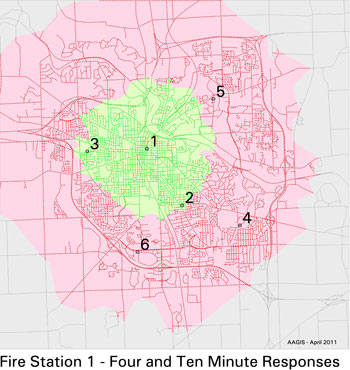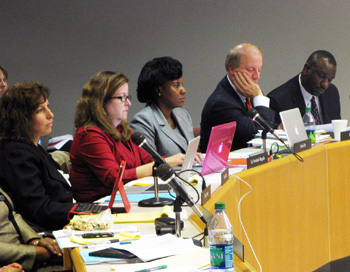Christmas came a little early for Ann Arbor’s fire department, as well as for the local news media. A report on Ann Arbor’s fire protection services arrived five days before Santa.

This does not depict Ann Arbor dressed in Christmas colors. Numbered locations are fire stations. This map pertains to Station #1. The green area is the area of the city reachable from Station #1 in four minutes. The red area corresponds to 10 minutes. (Image links to higher resolution file)
The report was a long time arriving, though. It was almost a year ago – on Feb. 7, 2011 – when the Ann Arbor city council authorized the expenditure of up to $54,000 for a contract with the International City/County Management Association to conduct the study.
It was a study that then-city administrator Roger Fraser had wanted, and it came in the context of a city council budget retreat a month earlier. At that retreat, councilmembers were briefed on various alternatives to the city’s current approach to staffing its fire protection – including an approach that uses a combination of paid on-call and full-time fire service professionals. At the same council meeting when the ICMA report was authorized, Stephen Rapundalo, who at the time was chair of the city council’s labor committee, criticized the city’s firefighters union for its reluctance to accept a benefits package similar to the one for non-union city workers.
So, how important was the ICMA fire protection study to the city?
Here’s one way of answering that. When Fraser announced his resignation, the city council’s search committee identified in April of this year a handful of top priority items for the interim administrator. The interim – Tom Crawford, the city’s CFO – was supposed to keep the place running, and make sure a small list of priority items didn’t fall through the cracks during the transition in the city’s top position. The ICMA fire protection study made the list.
The report was originally due in the spring, and then was delayed, and delayed again. The city was paying the ICMA for its work – a total of $38,000 in June 2011. I spoke with Crawford about the report this fall – he couldn’t offer much in the way of explanation, but indicated that the delay was on the ICMA’s end.
New city administrator Steve Powers started the job in mid-September. No ICMA report had materialized. Then in mid-November, the city paid an additional $400 to the ICMA. Shortly after that, word filtered through firefighter rank-and-file that a draft report had been released to the city by the ICMA.
At the time, The Chronicle had a Freedom of Information Act (FOIA) request pending with the city for a different set of records – maps depicting fire response-time boundary areas. Why? I’d seen one such map hanging in a public area on the second floor of city hall, that had – ahem – sparked a burning desire to see copies of all such maps.
When that request came back partly denied (no maps were produced), The Chronicle submitted a “clarification” of the original request, and added a request for the draft ICMA report. Other media had reported that their request for the draft report had been denied – but the city’s given reason for the denial was, to us, simply wrong. We figured that citing a specific prior court case might give us a shot.
We didn’t receive a denial. Instead, the city asserted its right to a 10-day time extension. And apparently this extension came on the very same day that the city turned down an appeal made by a different requester regarding the city’s denial of a similar request. It’s not entirely clear why the city denied an appeal made on one request, while on the same day claiming an extension for a similar request – from a different requester.
During the extension, I approached Powers, essentially outside the formal mechanism of the FOIA process. My pitch to Powers was not a legal argument. My pitch was based on the organizational interests of the city and the public interest of the community. We met on Friday, Dec. 16.
In that meeting, Powers assured me the draft report, the final report (which is still watermarked “draft”) and the maps would be released the following week. And the records were, in fact, released. We withdrew our FOIA request when we got the information we requested.
So Christmas did come early, right? But seriously, WTF? By the way, that does translate politely – as “Where’s the fire?”
We got what we wanted, and we should be happy about that.
Yet I still feel like the city wrapped up new socks and underwear in colored paper and called it a Christmas present. I want socks and underwear every time I yell FOIA in this democratic theater that we call Ann Arbor, not just at Christmas time. [Full Story]









